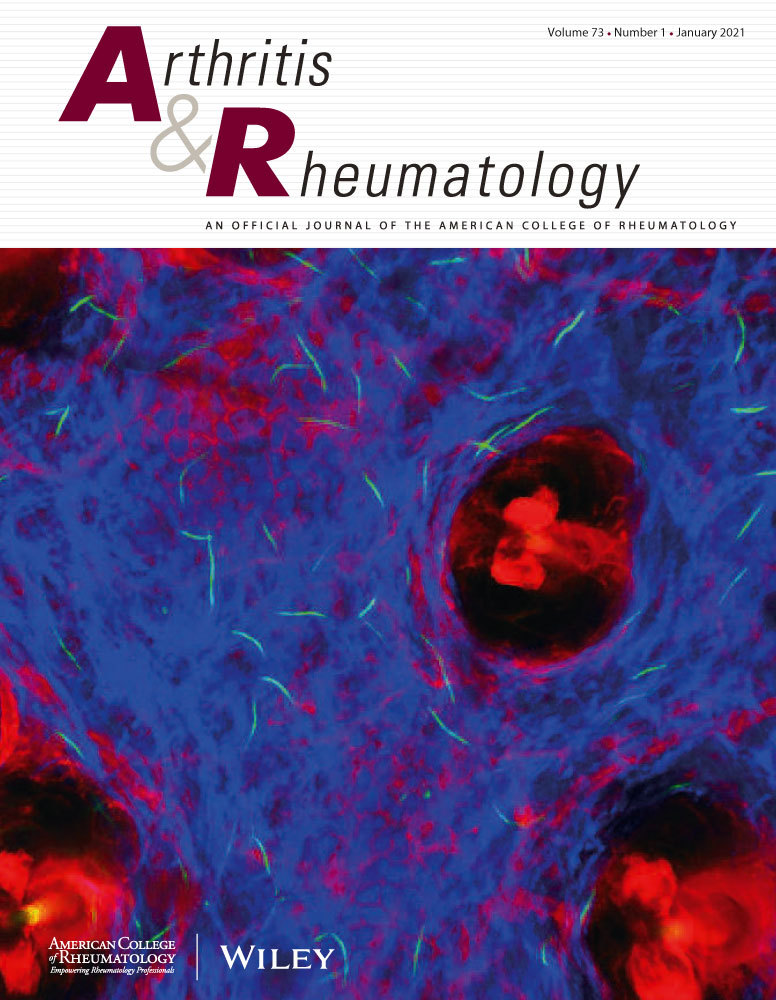Benralizumab和美polizumab对嗜酸性肉芽肿合并多血管炎患者口服糖皮质激素使用的影响。
IF 10.9
1区 医学
Q1 RHEUMATOLOGY
引用次数: 0
摘要
目的:3期MANDARA研究表明,benralizumab与mepolizumab相比,对于嗜酸性肉芽肿病合并多血管炎(EGPA)患者的缓解无劣效性。更多接受贝那单抗治疗的患者实现了口服糖皮质激素(OGCs)的完全停药。这些事后分析进一步阐明了benralizumab和mepolizumab在促进OGCs减少方面的功效。方法:需要≥7.5 mg/天OGC±免疫抑制治疗的EGPA成人随机分为贝那利珠单抗30mg (n=70)或mepolizumab 300mg (n=70),每4周皮下注射一次,持续52周。研究人员根据临床判断逐渐减少稳定EGPA患者的OGCs。如果在第40周达到并维持到第52周,则认为OGC使用量的减少(降至≤4mg/天,减少≥50%,或完全停药)是持续的。结果两组患者OGC 12个月累积剂量均为~ 1800 mg。在第49-52周,benralizumab和mepolizumab的中位(最小-最大)OGC剂量分别为1.16(0.0-16.6)和3.00 (0.0-25.7)mg/天。首次或持续将OGC减少到≤4mg/天或减少≥50%的时间,以及累计无OGC持续时间,两组之间相似。与mepolizumab治疗的患者相比,更多的benralizumab治疗的患者完全戒除了OGCs (33/70 vs 20/70;首次完全戒除的时间比(HR)为1.84 [95%CI, 1.06, 3.27],无分层log-rank检验p=0.0291)和持续完全戒除(17/70 vs 7/70;减少时间比(HR)为2.97 [95%CI: 1.26,7.77],无分层log-rank检验p=0.0268)。在两组患者亚组中,完全停用OGC的情况相似,包括ANCA状态和免疫抑制剂使用情况。结论benralizumab靶向白介素-5受体或mepolizumab靶向循环白介素-5是EGPA患者有效的ogc节约策略。本文章由计算机程序翻译,如有差异,请以英文原文为准。
The Effect of Benralizumab and Mepolizumab on Use of Oral Glucocorticoids in Patients with Eosinophilic Granulomatosis with Polyangiitis.
OBJECTIVE
The Phase 3 MANDARA study demonstrated non-inferiority of benralizumab versus mepolizumab for remission in patients with eosinophilic granulomatosis with polyangiitis (EGPA). More benralizumab-treated patients achieved complete withdrawal of oral glucocorticoids (OGCs). These post-hoc analyses further elucidate the efficacy of benralizumab and mepolizumab in facilitating reductions in OGCs.
METHODS
Adults with EGPA requiring ≥7.5 mg/day OGC ±immunosuppressive therapy were randomized to benralizumab 30mg (n=70) or mepolizumab 300mg (n=70) subcutaneously every 4 weeks for 52 weeks. Investigators tapered OGCs for patients with stable EGPA based on clinical judgment. Reductions in OGC use (to ≤4mg/day, by ≥50%, or complete withdrawal) were considered sustained if achieved by Week 40 and maintained through Week 52.
RESULTS
The 12-month cumulative dose of OGC was ~1,800 mg in both groups. At Weeks 49-52, the median (minimum-maximum) OGC dose was 1.16 (0.0-16.6) and 3.00 (0.0-25.7) mg/day for benralizumab and mepolizumab, respectively. Time to first or sustained OGC reduction to ≤4mg/day or by ≥50%, and accrued OGC-free duration, were similar between groups. More benralizumab- than mepolizumab-treated patients completely withdrew OGCs (33/70 vs 20/70; HR for time to first complete withdrawal 1.84 [95% CI, 1.06, 3.27], unstratified log-rank test p=0.0291) and sustained complete withdrawal (17/70 vs 7/70; HR for time to reduction 2.97 [95%CI: 1.26,7.77], unstratified log-rank test p=0.0268). In both groups, complete OGC withdrawal was similar across patient subgroups, including by ANCA status and immunosuppressive use.
CONCLUSION
Targeting the interleukin-5 receptor with benralizumab, or circulating interleukin-5 with mepolizumab, are effective OGC-sparing strategies in patients with EGPA.
求助全文
通过发布文献求助,成功后即可免费获取论文全文。
去求助
来源期刊

Arthritis & Rheumatology
RHEUMATOLOGY-
CiteScore
20.90
自引率
3.00%
发文量
371
期刊介绍:
Arthritis & Rheumatology is the official journal of the American College of Rheumatology and focuses on the natural history, pathophysiology, treatment, and outcome of rheumatic diseases. It is a peer-reviewed publication that aims to provide the highest quality basic and clinical research in this field. The journal covers a wide range of investigative areas and also includes review articles, editorials, and educational material for researchers and clinicians. Being recognized as a leading research journal in rheumatology, Arthritis & Rheumatology serves the global community of rheumatology investigators and clinicians.
 求助内容:
求助内容: 应助结果提醒方式:
应助结果提醒方式:


